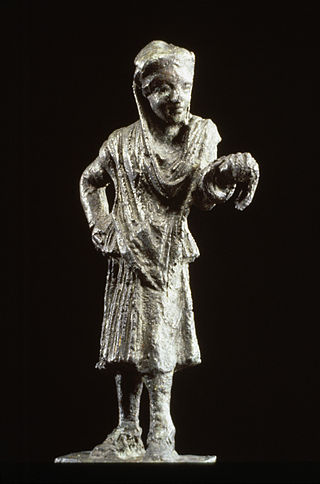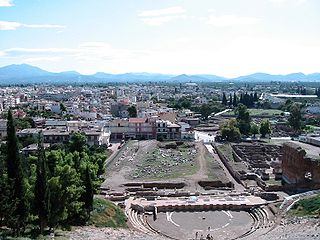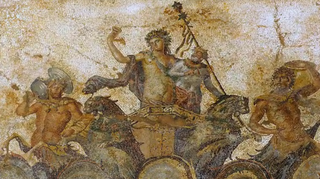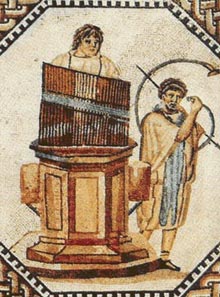
The largest building of the Archaeological Park of Dion in northern Greece is the Hellenistic-era theatre. It is located in the south of the village of Dion, Pieria and is often used during the summer for performances of the Olympus Festival.

The largest building of the Archaeological Park of Dion in northern Greece is the Hellenistic-era theatre. It is located in the south of the village of Dion, Pieria and is often used during the summer for performances of the Olympus Festival.
The theatre is located approximately 180 meters south of the entrance to the archaeological park. [1]

The form of the theatre corresponds to the typical theatre of Greek antiquity. It is an open-air structure that was built in a northeastern direction on the slope of a low, natural (partially heaped) hill. The orchestra was built on mashed soil and was surrounded by a drainage construction, to drain the rainwater. The drainage is uncovered, over two bridges it could be crossed by the actors. The orchestra has a diameter of about 26 meters. The stage was probably made of wood and was a bit higher than the current stage. Underneath the orchestra was an underground corridor, connecting two rooms.
Unique to Hellenistic theatres was the type of seats of the auditorium, the theatron ; The semicircular rows of seats were covered with 50 by 50 by 7 centimeters of mud bricks, the seats were a half brick width high. Before the beginning of the Roman period, the seats were covered with marble. The current form of the theater is the result of a modern reconstruction on the antique foundations. [2] The seats in the spectator area are now covered with wooden boards.
The gable of the theater building was adorned with a Doric entablature; the roof was covered with tiles in the Laconic style.

King Archelaos held a nine-day festival in honor of the nine Pieric Muses, which also included theatre competitions. He invited Euripides to Dion, who wrote the plays of Archelaos and the Bacchae. Both plays were probably also performed in Dion. [3]
The current theatre was built during the Hellenistic period, presumably during the reign of King Philip V. An earlier theatre occupied the same site, presumably destroyed during the assault of the Aetolian League, around 220 BC. Philip V immediately rebuilt the city of Dion, the shrines and the theatre. Within the structure was found a large quantity of coins depicting Philip V. In Roman times (from 168 BC) were removed useful building materials of the theatre and built a Roman theater near the sanctuary of Zeus.
After completion of renovation work, the theatre has been regularly hosting performances of the Olympus Festival since 1991.
The theatre was discovered in 1806 by the English explorer William M. Leake. [4] In 1855 the find was confirmed by the French archaeologist Léon Heuzey. [5] The first test excavations were carried out in 1970 under the direction of Professor G. Bakalakis. The regular excavation work began in 1973 under the direction of Professor Pandermalis. After the works rested for two years, they were resumed in 1977 by the architect and archaeologist Professor G. Karadedos. Since the building in the Roman period, was not paid any further attention, its basic structure remained unchanged. The excavations were carried out very carefully; thus, valuable information was obtained to allow conclusions about the original condition of the complex. The orchestra, the stage, the drainage, parts of the theater building and the main part of the Cavea were found. After the excavations were completed in 1988, Karadedos implemented a study for the “Conservation, Promotion and Temporary Re-operation of the Hellenistic Theatre of Dion”. [6]

Olynthus is an ancient city in present-day Chalcidice, Greece. It was built mostly on two flat-topped hills 30–40m in height, in a fertile plain at the head of the Gulf of Torone, near the neck of the peninsula of Pallene, about 2.5 kilometers from the sea, and about 60 stadia from Poteidaea. Artefacts found during the excavations of the site are exhibited in the Archaeological Museum of Olynthos.

Ancient Greek theatre was a theatrical culture that flourished in ancient Greece from 700 BC. The city-state of Athens, which became a significant cultural, political, and religious place during this period, was its centre, where the theatre was institutionalised as part of a festival called the Dionysia, which honoured the god Dionysus. Tragedy, comedy, and the satyr play were the three dramatic genres to emerge there. Athens exported the festival to its numerous colonies. Modern Western theatre comes, in large measure, from the theatre of ancient Greece, from which it borrows technical terminology, classification into genres, and many of its themes, stock characters, and plot elements.

Dion is a village and municipal unit in the municipality of Dion-Olympos in the Pieria regional unit, Greece. It is located at the foot of Mount Olympus at a distance of 17 km from the capital city of Katerini.

Orchomenus, the setting for many early Greek myths, is best known today as a rich archaeological site in Boeotia, Greece, that was inhabited from the Neolithic through the Hellenistic periods. It is often referred to as "Minyan Orchomenus", to distinguish it from a later city of the same name in Arcadia.

Hierapolis was originally a Phrygian cult centre of the Anatolian mother goddess of Cybele and later a Greek city. Its location was centred upon the remarkable and copious hot springs in classical Phrygia in southwestern Anatolia. Its extensive remains are adjacent to modern Pamukkale in Turkey.

Léon Heuzey was a noted French archaeologist and historian.

Olympus Festival is an annual festival of music and theatre and a major cultural event in Greece. It is the largest event of its kind in northern Greece and takes place annually in the months of July and August. The aim is to provide both, the local population and tourists, with cultural entertainment and thus to promote the contact between different cultures and the tourism of the region. The festival is supported by the Greek Ministry of Culture and the former municipality of Dion, as well as by other local authorities in Pieria.

The Ancient theatre of Ohrid of the Hellenistic period is located in Ohrid, North Macedonia. It was built in 200 BC and is the only Hellenistic-type theatre in the country as the other three in Scupi, Stobi and Heraklea Lynkestis are from Roman times. It is unclear how many people the original theater used to seat, as only the lower section still exists. The open theater has a perfect location: the two hills that surround it keep it protected from winds that could interfere with acoustics during performances.

The Archaeological Museum of Amphipolis is a museum in Amphipolis, Central Macedonia, Greece. It is located in the archaeological site of ancient Amphipolis, near River Strymon at close range of the Thessaloniki–Kavala national highway and within the walls of the ancient city itself. In the museum, finds from Amphipolis and its surroundings are exhibited. The excavations took place mainly in the period from 1956 to 1984, under the direction of the late archaeologist Dimitris Lazaridis. After his death (1985) his daughter, Calliope Lazaridis, continued the work until 1989.

The Archaeological Museum of Dion is a museum in Dion in the Pieria regional unit of Central Macedonia, Greece.

The Argos Theater was built in 320 BC. and is located in Argos, Greece against Larissa Hill. Nearby from this site is Agora, Roman Odeon, and the Baths of Argos. The theater is one of the largest architectural developments in Greece and was renovated in ca 120 AD.

The Ancient Theatre of Epidaurus is a theatre in the Greek city of Epidaurus, located on the southeast end of the sanctuary dedicated to the ancient Greek God of medicine, Asclepius. It is built on the west side of Cynortion Mountain, near modern Lygourio, and belongs to the Epidaurus Municipality. Constructed in late 4th century BC, it is considered to be the most perfect ancient Greek theatre with regard to acoustics and aesthetics. Because of its exceptional architecture and aesthetics, the theatre was inscribed on the UNESCO World Heritage List in 1988 along with the Temple of Asclepius.

The Archaeological Park of Dion is the most important archaeological site at Mount Olympus in Greece, located in Dion. In the area comprised by the Archaeological Park of Dion, sanctuaries were found from the Hellenistic and Roman periods. The park displays the importance of ancient Dion in the history of Pieria.

The Dionysus mosaic is the largest preserved mosaic found in excavations in Dion. It shows the epiphany of the triumphant Dionysus.

Pydna is an ancient Greek city in the regional unit of Pieria, Central Macedonia, Greece. It is an important place in the history of Pieria and a major archaeological site located directly at the Aegean Sea, 16 km northeast of Katerini, 28 km north-east of Dion and 2.5 km from the village of Makrygialos. Nearby are two Macedonian tombs, discovered by the French archaeologist Heuzey during his Greek travels in the mid-19th century. Furthermore, the fortress-like bishop's seat Louloudies is located a few kilometers south of Pydna.

The Hydraulis of Dion Greek: Ύδραυλις του Δίου; romanized: Ídravlis tou Díou) is a unique exhibit of the Archaeological Museum of Dion. It is the earliest archeological example of a pipe organ to date.

The Christianization of the Olympus region began relatively early. While the episcopal seats from Byzantine times only remaining ruins, inhabited and used monasteries and churches are still present at this time at Olympus. Some of the monasteries are a stauropegion, ie they are directly subordinate to the Patriarch of Constantinople, others belong to a diocese. The number of churches and chapels around Mount Olympus is hard to overlook. That is why only the monasteries and most important churches are mentioned.

This is a reflection of the main historical events in Pieria (Πιερία), Central Macedonia.